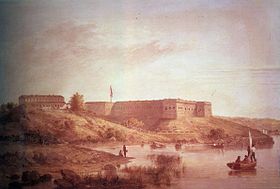Fort Trumbull
|
Fort Trumbull
|
|

Fort Trumbull as constructed after 1839,
painted by Seth Eastman under commission of the US Army in 1870 |
|
| Location | Fort Neck New London, Connecticut |
|---|---|
| NRHP Reference # | 72001333 |
| Added to NRHP | September 22, 1972 |
Fort Trumbull was a fort named for Governor Jonathan Trumbull first completed in 1777 near the mouth of the Thames River on Long Island Sound at New London, Connecticut. The present fortification was built between 1839 and 1852. The site lies adjacent to Coast Guard Station New London and is managed as 16-acre Fort Trumbull State Park by the Connecticut Department of Energy and Environmental Protection.
In 1775, Governor Jonathan Trumbull recommended building a fortification at the port of New London to protect the seat of the government of Connecticut. The fort was built on a rocky point of land near the mouth of the Thames River on Long Island Sound; it was completed in 1777 and named for Governor Trumbull, who served from 1769 to 1784. It was attacked in 1781 during the American Revolutionary War, and was captured by British forces under the command of Benedict Arnold.
The infamous traitor Benedict Arnold was serving as a brigadier general in the British Army when he led a raid on Groton and New London, Connecticut on September 6, 1781. Two bodies of troops were landed on either side of the mouth of the Thames River and marched towards Fort Trumbull in New London and Fort Griswold in Groton.
Fort Trumbull fell after little resistance, but about 150 Connecticut militiamen made a gallant stand at Fort Griswold in the Battle of Groton Heights. The British were finally able to enter the fort, and militia commander Lieutenant Colonel William Ledyard offered his sword to Major Bromfield, the British commander on the scene, as a token of surrender. According to contemporaneous accounts, Bromfield took the sword from Ledyard and drove it through him, and the British then proceeded to massacre the surviving defenders. Eighty five of the militiamen were killed and the others were either severely wounded, taken prisoner, or managed to escape.
...
Wikipedia
